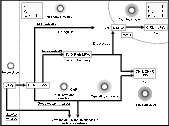

Up: Stellar and circumstellar evolution
5 Conclusion
Our results confirm that the AGB evolution depends on the initial mass of
the progenitor on the main sequence. The study of LPVs with peculiar
properties, often associated with transition states in the stellar evolution,
elucidates some points of the very complex evolution along the AGB.
The simultaneous study of the behaviour of the circumstellar envelope provides
further information on the evolutive state of the stars along the AGB.
However, this study is mainly statistical and so
results for individual stars can be erroneous because the confidence
level of a probabilistic discrimination can never reach 100%.
The proposed evolutive scenario, schematically represented in Fig. 7, is:
- At the beginning of the variability phase, stars
belonging to the disk 2 or old disk population (i.e., with
a not too large initial mass
 )
are irregular L or
semi-regular SRb O-rich variables. They begin to slowly produce
an envelope. Thereafter the envelope expands, and the IRAS luminosities of the star rapidly grow brighter. They become O-rich
SRa or Mira. Depending on smaller or greater
)
are irregular L or
semi-regular SRb O-rich variables. They begin to slowly produce
an envelope. Thereafter the envelope expands, and the IRAS luminosities of the star rapidly grow brighter. They become O-rich
SRa or Mira. Depending on smaller or greater
 ,
they can evolve either to OH emitters and finally OH-IR sources
or, for the more massive, to be enriched in s elements and then in
carbon by successive dredge-ups and finally become a C-rich
Mira. The least massive stars leave the AGB with no special
transformation of their surface abundance;
,
they can evolve either to OH emitters and finally OH-IR sources
or, for the more massive, to be enriched in s elements and then in
carbon by successive dredge-ups and finally become a C-rich
Mira. The least massive stars leave the AGB with no special
transformation of their surface abundance;
- The disk 1 and bright disk population LPVs seem to very rapidly build a
bright expanding envelope. They can also evolve to OH or C-rich stars.
Although this population is not attractive for O-rich LPVs, a tenth
of OH Mira belong to it. They are probably not massive enough to be
sufficiently carbon enriched. A few may be HBB stars.
If the mass of the star is high enough, after a number of dredge-ups
the external shells of the star can be enriched in carbon. The C/O
ratio becomes larger than 1. When C/O
is around 1, the star is an S star. At the same time, strong changes
take place in the circumstellar envelope, which becomes dominated by
carbonated grains, and the 25-12 index increases in conformity with
the loop drawn in the IRAS color-color diagram, as predicted by Willems
& de Jong (1988) and calculated by Chan & Kwok (1988).
Our luminosity calibrations in 12 and 25 clearly show that
the star becomes fainter in both luminosities but more in 25 than
in 12. The C-rich irregular and SRb stars seem to be the most evolved
and massive.
The study of LPVs enriched in Tc confirms that they are at different
stages along the AGB but after a recent dredge-up. It allows us to confirm
the location of the first dredge-up at
 and the quite early
operative third dredge-up on the TP-AGB
and the quite early
operative third dredge-up on the TP-AGB
 |
Figure 7:
Schematic illustration of the proposed stellar and circumstellar
evolutive scenario. |
The no-Tc S-type LPVs (except R And), are faint in K, 12 and 25, and they
are confirmed as extrinsic S stars enriched not by their own
nucleosynthesis but by mass exchange from a more evolved companion. The
extrinsic enrichment in s-elements may accelerate the evolution along
the AGB and lead to the formation of an envelope closer to being
carbonated than silicated before any intrinsic enrichment by successive
dredge-ups.
The examination of the brightest LPVs allows us to
propose a list of stars with peculiar spectral, envelope and
luminosity properties that may be Hot Bottom Burning candidates.
The most luminous of them, R Cen, a star in a He-shell flash,
could become, before leaving AGB, a C-rich LPV brighter than the usual
luminosity limit of carbon stars.
Acknowledgements
This study was supported by the PICASSO program PICS 348 and by the
CICYT under contract ESP97-1803 and AYA2000-0937. We thank
N. Mowlavi and R. Alvarez for constructive remarks and
A. Gomez and S. Van Eck for fruitful discussions of our preliminary results.


Up: Stellar and circumstellar evolution
Copyright ESO 2001
